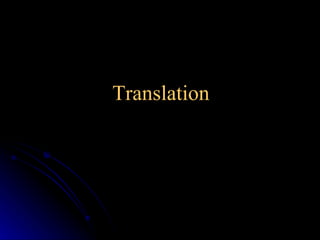Translation
•Transferir como PPT, PDF•
2 gostaram•1,010 visualizações
Denunciar
Compartilhar
Denunciar
Compartilhar

Recomendados
Mais conteúdo relacionado
Mais procurados
Mais procurados (20)
DNA transcription & Post Transcriptional Modification

DNA transcription & Post Transcriptional Modification
Ribosomes - Origin, Chemical composition, Structure and Function

Ribosomes - Origin, Chemical composition, Structure and Function
Semelhante a Translation
Semelhante a Translation (20)
please explain transcription and translationSolutionAnsTran.pdf

please explain transcription and translationSolutionAnsTran.pdf
Transcriptional, Translational, and Post-translational Regulation.pdf

Transcriptional, Translational, and Post-translational Regulation.pdf
Transcriptional, Translational, and Post-translational Regulation.pdf

Transcriptional, Translational, and Post-translational Regulation.pdf
Mais de dreyngerous
Mais de dreyngerous (16)
Último
Último (20)
Cloud Frontiers: A Deep Dive into Serverless Spatial Data and FME

Cloud Frontiers: A Deep Dive into Serverless Spatial Data and FME
Emergent Methods: Multi-lingual narrative tracking in the news - real-time ex...

Emergent Methods: Multi-lingual narrative tracking in the news - real-time ex...
EMPOWERMENT TECHNOLOGY GRADE 11 QUARTER 2 REVIEWER

EMPOWERMENT TECHNOLOGY GRADE 11 QUARTER 2 REVIEWER
Web Form Automation for Bonterra Impact Management (fka Social Solutions Apri...

Web Form Automation for Bonterra Impact Management (fka Social Solutions Apri...
How to Troubleshoot Apps for the Modern Connected Worker

How to Troubleshoot Apps for the Modern Connected Worker
Elevate Developer Efficiency & build GenAI Application with Amazon Q

Elevate Developer Efficiency & build GenAI Application with Amazon Q
Strategies for Landing an Oracle DBA Job as a Fresher

Strategies for Landing an Oracle DBA Job as a Fresher
"I see eyes in my soup": How Delivery Hero implemented the safety system for ...

"I see eyes in my soup": How Delivery Hero implemented the safety system for ...
DEV meet-up UiPath Document Understanding May 7 2024 Amsterdam

DEV meet-up UiPath Document Understanding May 7 2024 Amsterdam
Polkadot JAM Slides - Token2049 - By Dr. Gavin Wood

Polkadot JAM Slides - Token2049 - By Dr. Gavin Wood
TrustArc Webinar - Unlock the Power of AI-Driven Data Discovery

TrustArc Webinar - Unlock the Power of AI-Driven Data Discovery
Cloud Frontiers: A Deep Dive into Serverless Spatial Data and FME

Cloud Frontiers: A Deep Dive into Serverless Spatial Data and FME
Apidays New York 2024 - APIs in 2030: The Risk of Technological Sleepwalk by ...

Apidays New York 2024 - APIs in 2030: The Risk of Technological Sleepwalk by ...
Translation
- 1. Translation
- 10. Summary Ribosome decodes the m-RNA and makes the correct protein. m-RNA Ribosomes Peptidyl transferase enzyme Transfer RNAs In the cytoplasm, on the ribosomes Translation Gene is activated. A copy of the code is made from RNA (m-RNA) m-RNA leaves the nucleus, goes to cytoplasm. DNA gene RNA polymerase In the nucleus Transcription Notes Major Components Where Process
